NESTLED IN the beach town of Ocean City, New Jersey, a nondescript summer home stands among rows of vacation rentals. Inside in the darkness, a hawk snoozes, a hungry falcon flaps its wings, and an owl stares intensely with orange eyes. This birdy hangout is not a summer home: It’s a falconry mews, where up to 18 birds of prey, or raptors, eat, rest, cool off, and get groomed.
Just before 10 a.m., as the town’s 2.5-mile boardwalk comes to life with shorebirds and humans riding bikes, veteran falconer Bill Brown is outside the mews preparing to feed a quail to a large Harris’s hawk named Karen. He’s been tending to her for only a few days, so the two are getting better acquainted. Brown smiles and talks to Karen as if she were a family member. To him, birds and the ancient art of falconry are sacred. “Once it’s in your blood, it’s in your blood,” he explains.
Ocean City’s lifeblood is its popular boardwalk, which Karen and the other birds from the mews defend with beak and talon. Packed with candy-colored miniature golf courses, two amusement parks, one water park, and countless caloric delights, the beachside attraction sees hundreds of thousands of visitors each year.
While “America’s Greatest Family Resort” boasts 8 miles of beaches and a welcoming atmosphere, the boardwalk has become known for a more menacing presence in recent years: gulls who watch for their chance to swoop in and steal everything from Old Bay-seasoned French fries to funnel cake to entire cones of chocolate custard.
 In previous years, the city used flyers with photos like these, warning visitors not to feed the seagulls. City of Ocean City
In previous years, the city used flyers with photos like these, warning visitors not to feed the seagulls. City of Ocean City
“I mean, [the birds are] aggressive, like borderline attacking and going for people’s food. It became a very serious scenic safety risk for a lot of the families on the boardwalk, and they wouldn’t even see it coming,” says Wes Kazmarck, a lifelong Ocean City resident and the president of the Boardwalk Merchants Association.
Kazmarck owns the Surf Mall, one of the larger businesses on the boardwalk, which sells an assortment of souvenirs and beach gear. He remembers frightened and confused gulls darting into the store and then desperately trying to escape. It created a hazard for shoppers as the birds frantically flapped their wings and zoomed around the store. “We really couldn’t get them out until the mall was closed. Then you’re pulling a 15-hour day and you want to go home, but instead you’re trying to get a seagull out of the building. That situation was terrible,” says Kazmarck.
Charlene and Bruce Twiggs, who have lived on the island full time for more than 30 years, also watched as the gulls’ aggression transformed from a nonissue into something more serious. “I was eating a sandwich, and I turned my head to talk to someone, and it came down just like that. It got my hair and everything as it was pulling away with my sandwich,” laughs Charlene, recounting a story from a few years ago.
Ocean City officials knew that they needed to act for safety, public health, and tourism, but they didn’t place a bet on weapons or harmful chemical pest control methods. Instead, they looked to the past with the thousands-year-old art of falconry. Today, a group of raptors and their handlers harness the power of the predator-prey relationship on the city’s boardwalk to keep the gulls away from food-laden tourists and push them toward the water, where they typically forage. While this abatement program is lauded by many scientists as a good solution at the moment, it’s also a statement about just how much humans encroach on habitats up and down the Jersey Shore.
Quintessential opportunists
The relationship between humans and gulls is tense at best and deadly to the birds at worst. Often maligned as “rats with wings” (a nickname also shared by common pigeons) or “dump ducks,” the gritty seabirds have gotten used to grifting off humans in vacation spots, city lots, and landfills across the world. But their scavenging ways have set off a backlash. People have purposely fed gulls sandwiches laced with poison, shot them with guns, and even crushed their eggs.
“Seabirds have to navigate three realms. They have to fly; then they spend some of their time on land, at least to breed; then [they spend] some of their time in the ocean. That’s pretty incredible,” says Sarah Courchesne, a program ornithologist with Mass Audubon. “People have such a mixed relationship with them. They’ll feed them on purpose, and on the same beach, someone else is flailing at [the gulls] with a baseball bat because they’re so enraged with something [being] near them.”
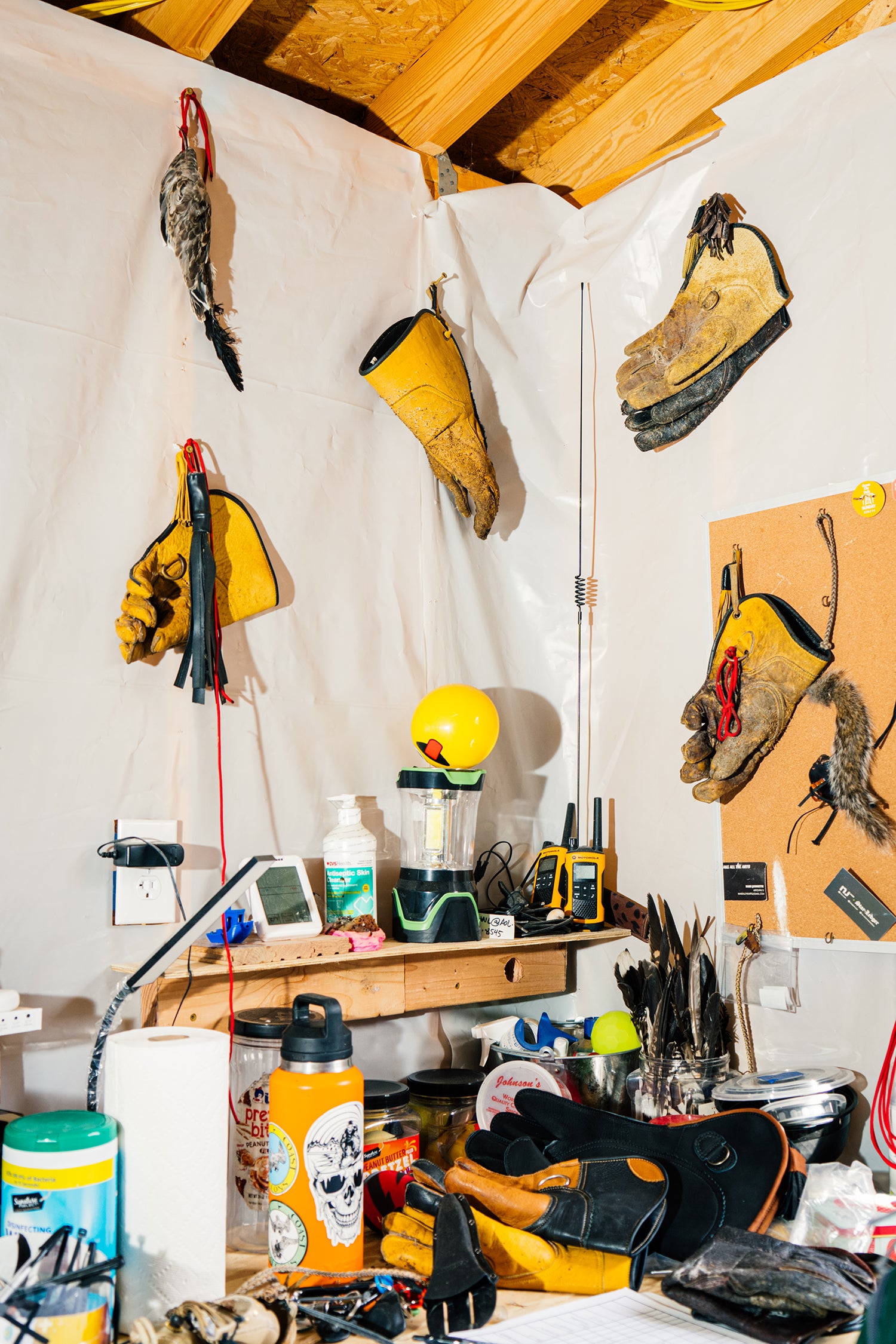 Inside the mews, where up to 18 raptors will rest, eat, have their beaks and talons attended to, and cool off from the summer heat. Jutharat Pinyodoonyachet for Popular Science
Inside the mews, where up to 18 raptors will rest, eat, have their beaks and talons attended to, and cool off from the summer heat. Jutharat Pinyodoonyachet for Popular Science
Julie Ellis, a biologist with the University of Pennsylvania School of Veterinary Medicine in Philadelphia, calls gulls quintessential opportunists. “They’re really flexible in terms of what they eat and where they nest. They’re super adaptable,” she explains. This flexibility has given them an evolutionary advantage. Unless a predator like a human or a raptor is around, gulls rest easily at the top of the food chain. While most species of gulls typically do not start to breed until they are 2 to 4 years old, herring gulls begin at 5. This is a sign of their general success as a species; they don’t face pressures to reproduce quickly and keep their populations up.
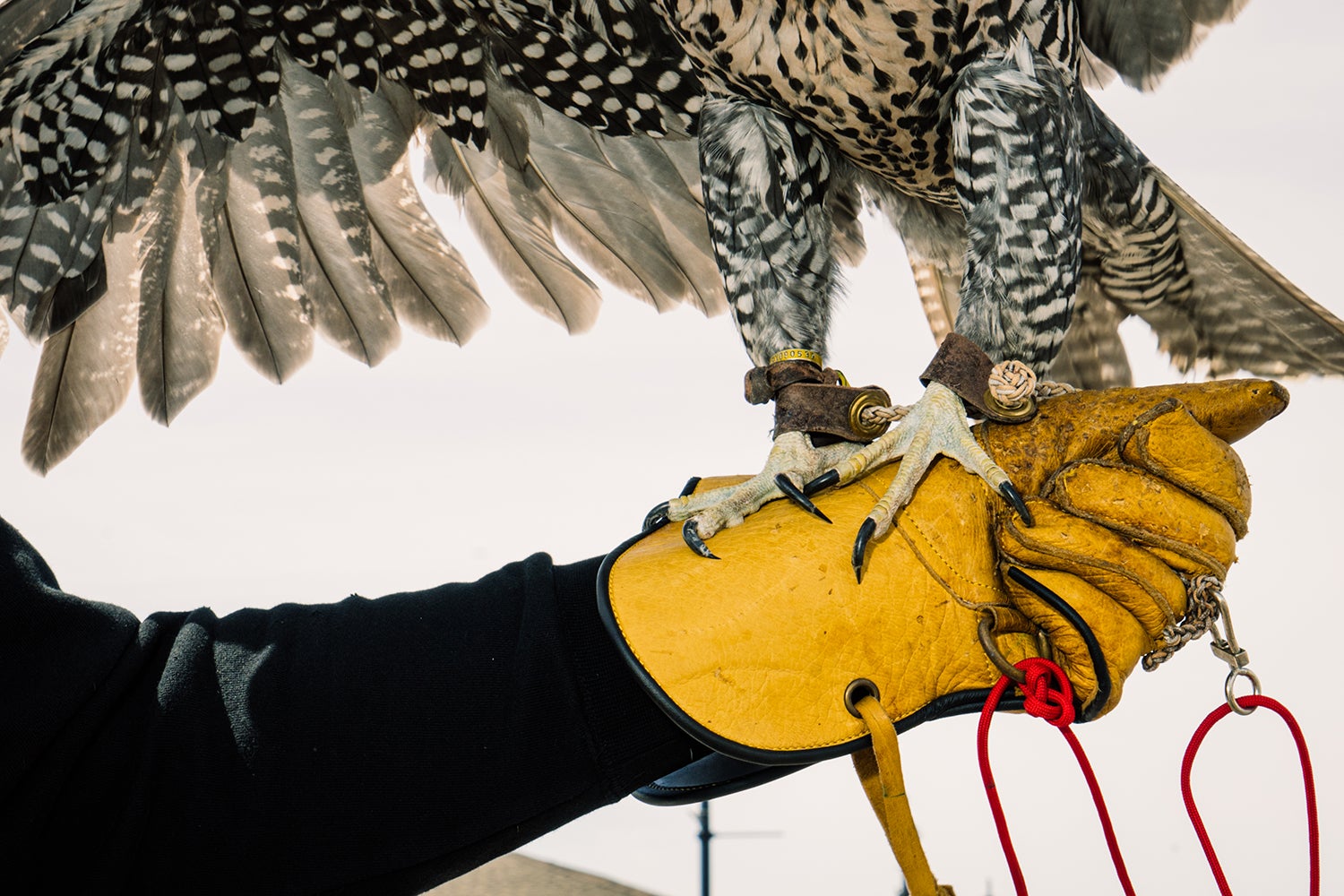 The birds respond to cues from falconers and land back on their gloves for rewards after completing tasks. Jutharat Pinyodoonyachet for Popular Science
The birds respond to cues from falconers and land back on their gloves for rewards after completing tasks. Jutharat Pinyodoonyachet for Popular Science
That also gives them room to learn about people and different survival techniques from a young age, says Noah Perlut, an ornithologist at the University of New England in Maine. “They’re watching our behavior constantly, nonstop. Their eyes are always open, seeing everything that’s happening. They’re studying us.”
Herring gulls have even been observed tracking human eye movements to try to follow what we are seeing. At times, they’ll risk getting close: If a gull realizes it’s safe enough to mingle with crowds, it will weave in and out of traffic to pick up discarded snacks. Sometimes caused by a process called habitation and sometimes just by the gulls’ individual risk-taking nature, certain birds are not afraid of our kind. Like people, they have individual personalities and talents—some won’t go anywhere near us, while others have developed the skill to go after food in busy places, like a boardwalk.
 Falconer Bill Brown patrols the boardwalk just north of the Music Pier with Karen, a Harris’s hawk who is the loudest bird in the mews. Jutharat Pinyodoonyachet for Popular Science
Falconer Bill Brown patrols the boardwalk just north of the Music Pier with Karen, a Harris’s hawk who is the loudest bird in the mews. Jutharat Pinyodoonyachet for Popular Science
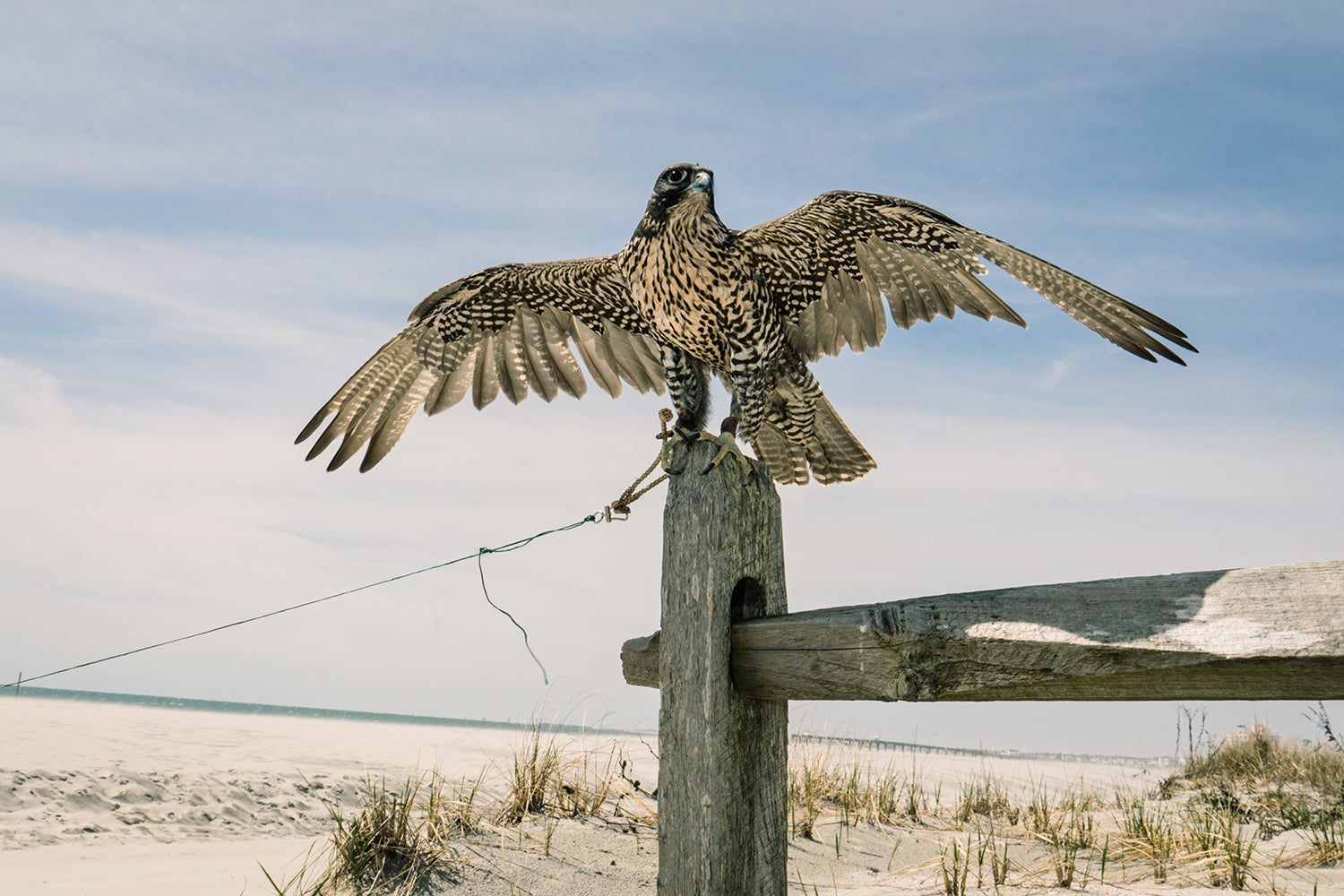 Diambi is getting used to being back on the boardwalk. Jutharat Pinyodoonyachet for Popular Science
Diambi is getting used to being back on the boardwalk. Jutharat Pinyodoonyachet for Popular Science
This buffet of human snacks has a complicated effect on the birds. Gulls on the coast primarily stick to a natural diet of clams, fish, and crustaceans. According to Ellis, there is some evidence that having human food sources in the winter and other lean times may help young birds survive as they’re learning how to forage. “But there is also evidence that eating hot dogs and junk food is not so great for reproduction,” she says.
While most species of gulls are nowhere near extinction, certain populations around the world have declined as much as 70 percent since the 1970s. Warming oceans have shifted the birds’ aquatic food sources, and rising sea levels encroach on their nesting sites. However, people also directly threaten them in small ways.
“The things that are their greatest strengths are the things that humans tend to despise them for,” Courchesne says. “We have this theme in the way we look at wildlife where the more strongly associated a wild species is with humans, the more we hate it. We like things that … live way off in the wilderness.”
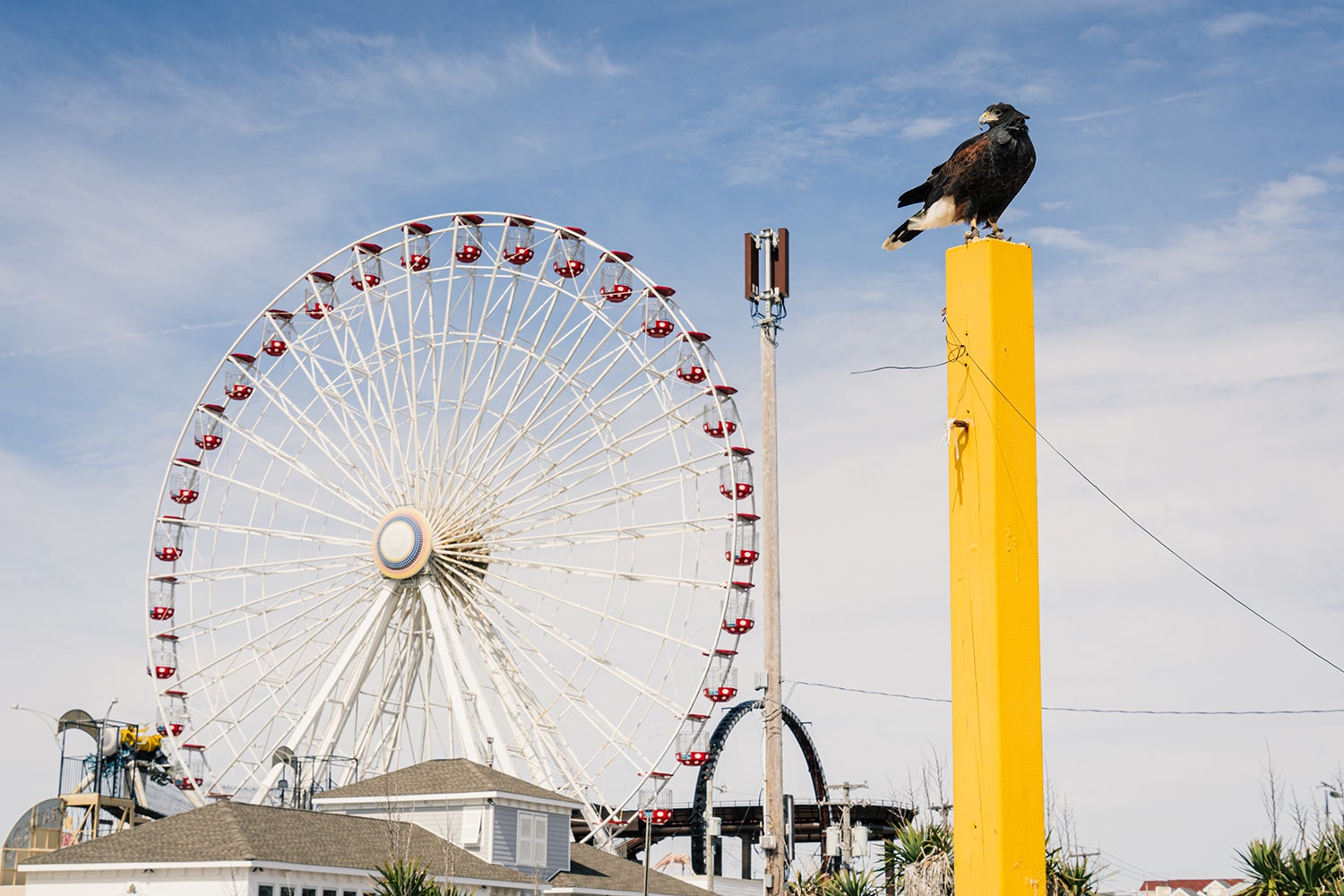 Karen sits atop a post near the city’s iconic Ferris wheel from Gillian’s Wonderland Pier. Jutharat Pinyodoonyachet for Popular Science
Karen sits atop a post near the city’s iconic Ferris wheel from Gillian’s Wonderland Pier. Jutharat Pinyodoonyachet for Popular Science
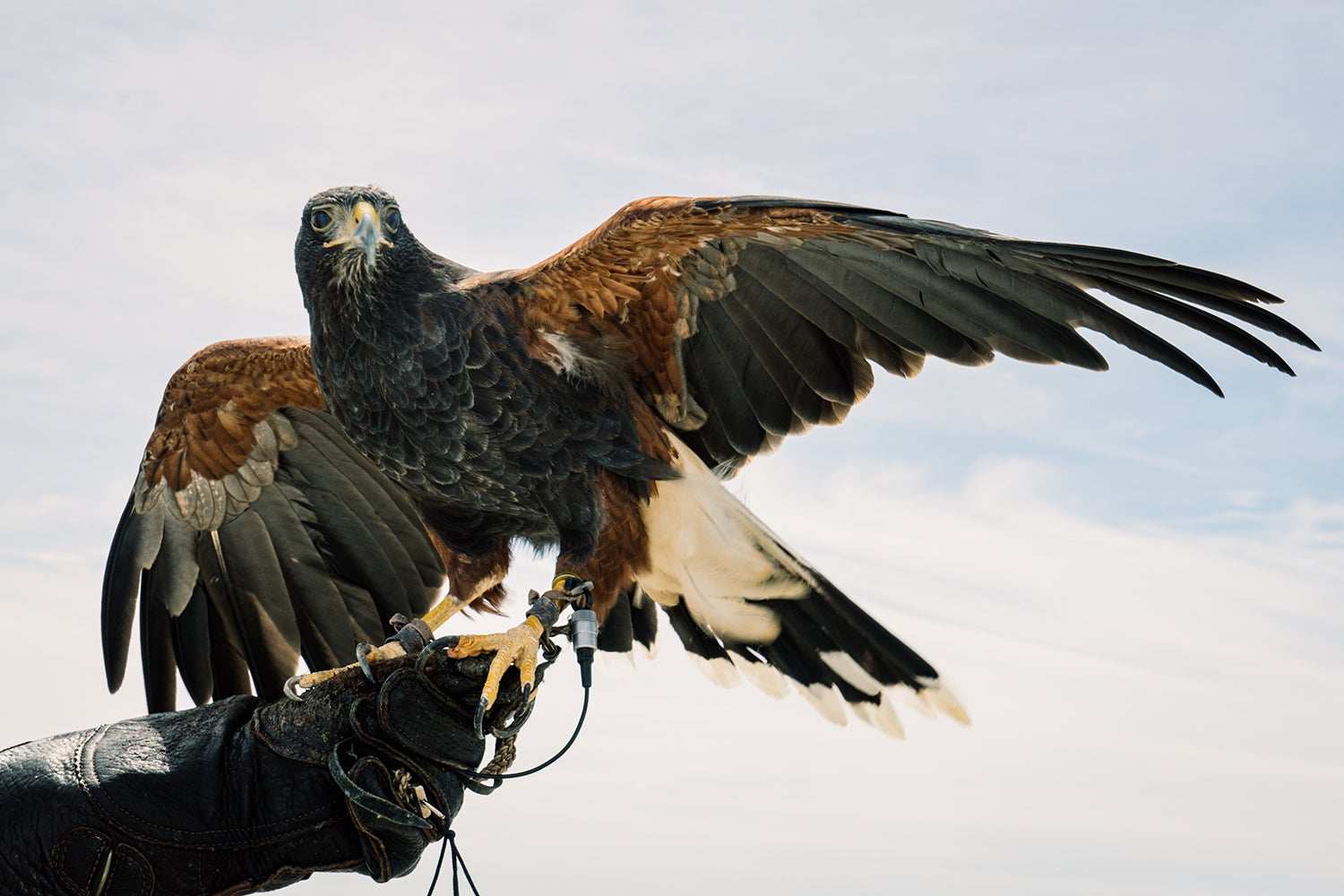 Trained raptors like Karen patrol a smaller and more concentrated area of the boardwalk. Jutharat Pinyodoonyachet for Popular Science
Trained raptors like Karen patrol a smaller and more concentrated area of the boardwalk. Jutharat Pinyodoonyachet for Popular Science
In Ocean City, the conflict emerges as gulls are forced to contend with a human population that can swell from under 12,000 to roughly 150,000 in the summer. The birds’ numbers increase as well, with the return of some flocks that left for the winter and the arrival of newer juvenile gulls from April to July. Laughing gulls represent the majority of the boardwalk’s french fry thieves—their signature calls provide a natural soundtrack to summer. But the island, which runs along a major migratory flyway, provides a haven for many avian kinds, including herring gulls, great black-backed gulls, peregrine falcons, piping plovers, and ospreys.
Initially, boardwalk merchants tried everything from netting to spike stirrups to sound machines to keep the gulls away—with little success. The birds’ increasing boldness reached a boiling point in 2019, when longtime mayor and third-generation boardwalk business owner Jay Gillian decided he’d had enough.
“When I watched a gull swoop down on a stroller and hit a toddler’s face, I knew that we had to try something different,” Gillian says. He asked the town’s business administrator to search for solutions, and they eventually found East Coast Falcons based in Lodi, New Jersey. The group uses raptors as a natural form of pest control called abatement: The trained, captive-bred hunters will chase and scare away pest species such as gulls and pigeons, but usually will not kill them.
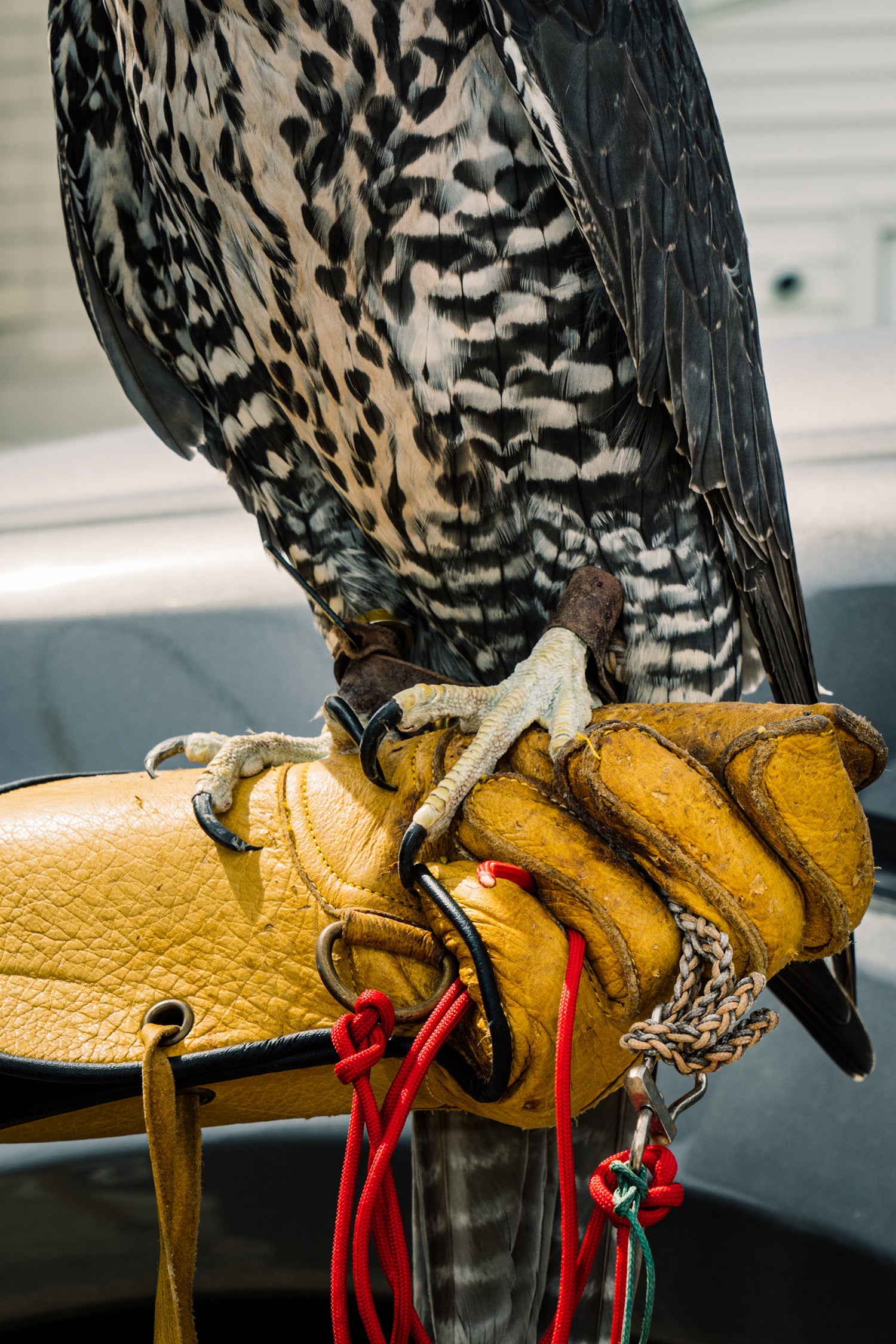 Falcons like Diambi use their impressive speed to strike prey, but their talons are also intimidating and mighty. Jutharat Pinyodoonyachet for Popular Science
Falcons like Diambi use their impressive speed to strike prey, but their talons are also intimidating and mighty. Jutharat Pinyodoonyachet for Popular Science
The city hired East Coast Falcons to patrol the boardwalk with their birds of prey for 12 hours a day from August 3 to September 2, 2019, as a test run. The effect was almost immediate. “It was pretty remarkable to see the gulls scatter from their very first sight of a falcon in the air. We believed right away that this would be a success,” Gillian recalls.
Fast forward to early 2023, when the city announced a three-year contract with East Coast Falcons worth up to $317,000. Instead of covering only the busiest summer months, the abatement program now starts on April 7 and will run until October 22, covering the height of tourist season and the months that border it. The raptors will patrol the island, including the boardwalk and along Asbury Avenue, a popular destination for families at the center of the island.
“Especially since COVID, outdoor dining has become more popular, and Ocean City is increasingly becoming a year-round town. The expansion of the program serves our downtown shopping and dining district and the important shoulder seasons for all our businesses,” Gillian says.
The birds are back in town
The idea of humans pitting nature against nature as a form of biological control has become almost commonplace in America. The University of New England recently opted to control the school’s mosquito population with a combination of birds, bats, and plants—and reducing the use of noxious pesticides. Meanwhile, in California, Disneyland has allowed a colony of feral cats to roam free, keeping the non–Mickey Mouse rodent population under control. (While often effective, methods involving free-roaming felines can backfire and increase predation on native wildlife.)
In the same way, airports and landfills around the country have started bird abatement operations to keep flocks from grounding flights and getting killed by jet engines. But the boardwalk assignment on the Jersey Shore came as a surprise, even to a seasoned falconer like East Coast Falcons owner Erik Swanson.
“I was actually laughing when I came down and looked at this job,” Swanson says. “But then my wife and I saw that children [in Ocean City] were not having a good time. The greatest time of my life was going to the beach with my dad and my mother—it was magical. Here kids are running away from gulls.”
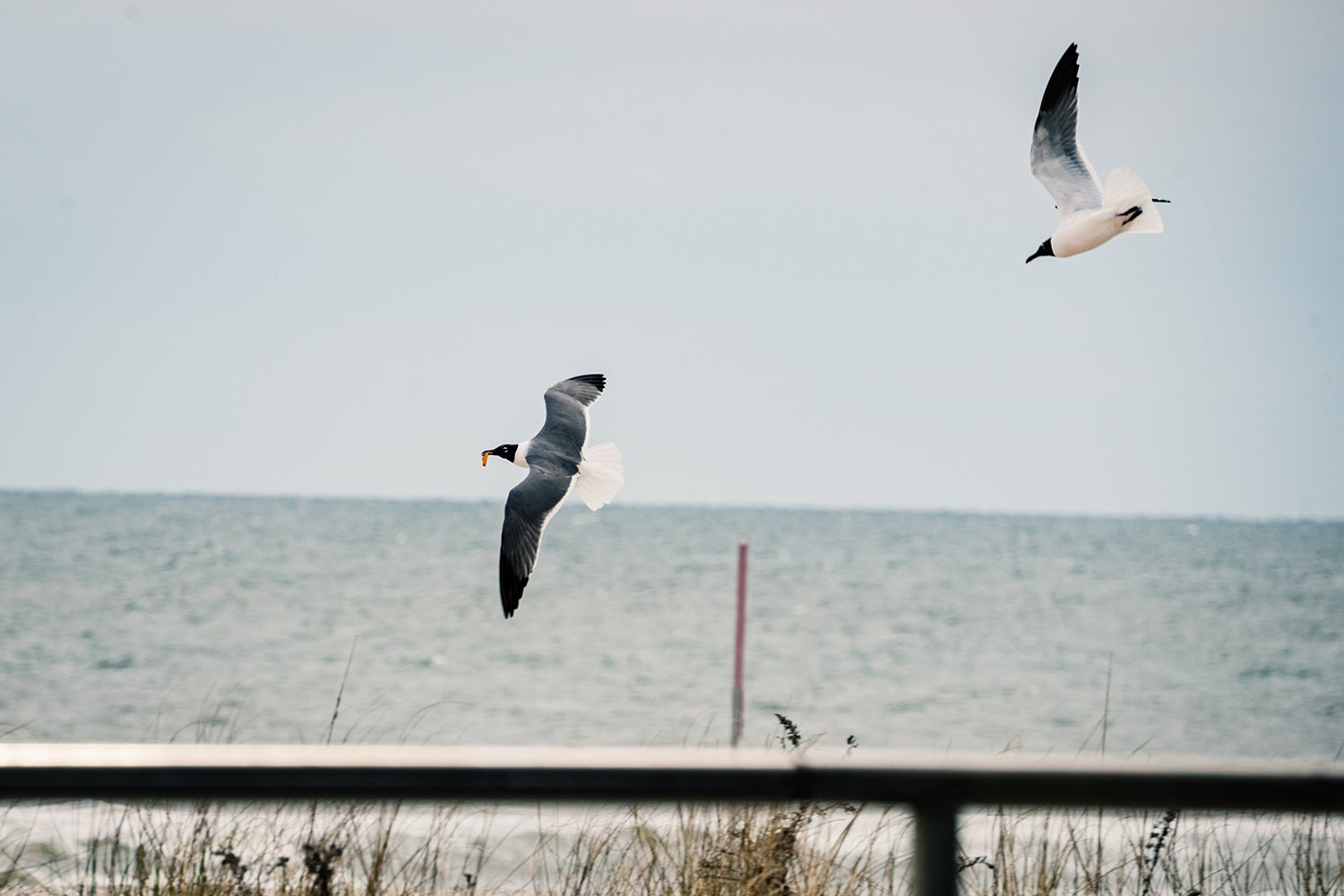 Two laughing gulls fly by the beach next to the boardwalk. One appears to have gotten into a bag of Cheetos. Jutharat Pinyodoonyachet for Popular Science
Two laughing gulls fly by the beach next to the boardwalk. One appears to have gotten into a bag of Cheetos. Jutharat Pinyodoonyachet for Popular Science
For the 2023 season, Swanson and his team are enlisting two Harris’s hawks, eight falcons of varying species, eight more back-up falcons, and one Eurasian eagle-owl to keep people’s food out of the beaks of Ocean City’s gulls. The raptors themselves have become local VIPs. On a busy Saturday in early spring, the falconers can’t even walk 6 feet without boardwalk visitors stopping to ask questions or comment on their sidekicks.
“The owl’s back! Does he still like mice? Wait, that’s a hawk,” pipes up one man with two teenagers in tow as a falcon named Diambi heads out to 10th Street beach for some training.
Another more bloodthirsty boardwalk patron says, “Oh, I hope he takes out a seagull!”
Ozzy, the Eurasian eagle-owl, is the longest-serving boardwalk bird in the mews; his species is among the largest of the world’s owls. As his handler strolls by with the imposing, 2-foot predator perched on his glove, people group together to get a closer look. Like any seasoned celebrity, Ozzy is completely unfazed by all the attention.
Owls, falcons, and hawks are highly adaptable, similar to the gulls that fear them. The flexibility makes them prime sidekicks for abatement and hunting with humans, according to Michelle Hawkins, a veterinarian professor at the University of California, Davis and director of the California Raptor Center. “These birds adjust to urban environments. [Falconers] go out there and kind of push them through all kinds of different extremes to get them comfortable with whatever they might come into contact with,” she says.
Hawkins and her team enlist help from falconers daily while rehabilitating injured birds. One way they collaborate is in training raptors like young eagles that would typically learn how to hunt from a parent in the wild. “The [falconers] teach us a lot. They’re working with their birds every single day, and they know everything about them,” says Hawkins.
 Tourists flock by as Ozzy the Eurasian eagle-owl stretches his wings near Manco & Manco, the boardwalk’s most popular pizza spot. Jutharat Pinyodoonyachet for Popular Science
Tourists flock by as Ozzy the Eurasian eagle-owl stretches his wings near Manco & Manco, the boardwalk’s most popular pizza spot. Jutharat Pinyodoonyachet for Popular Science
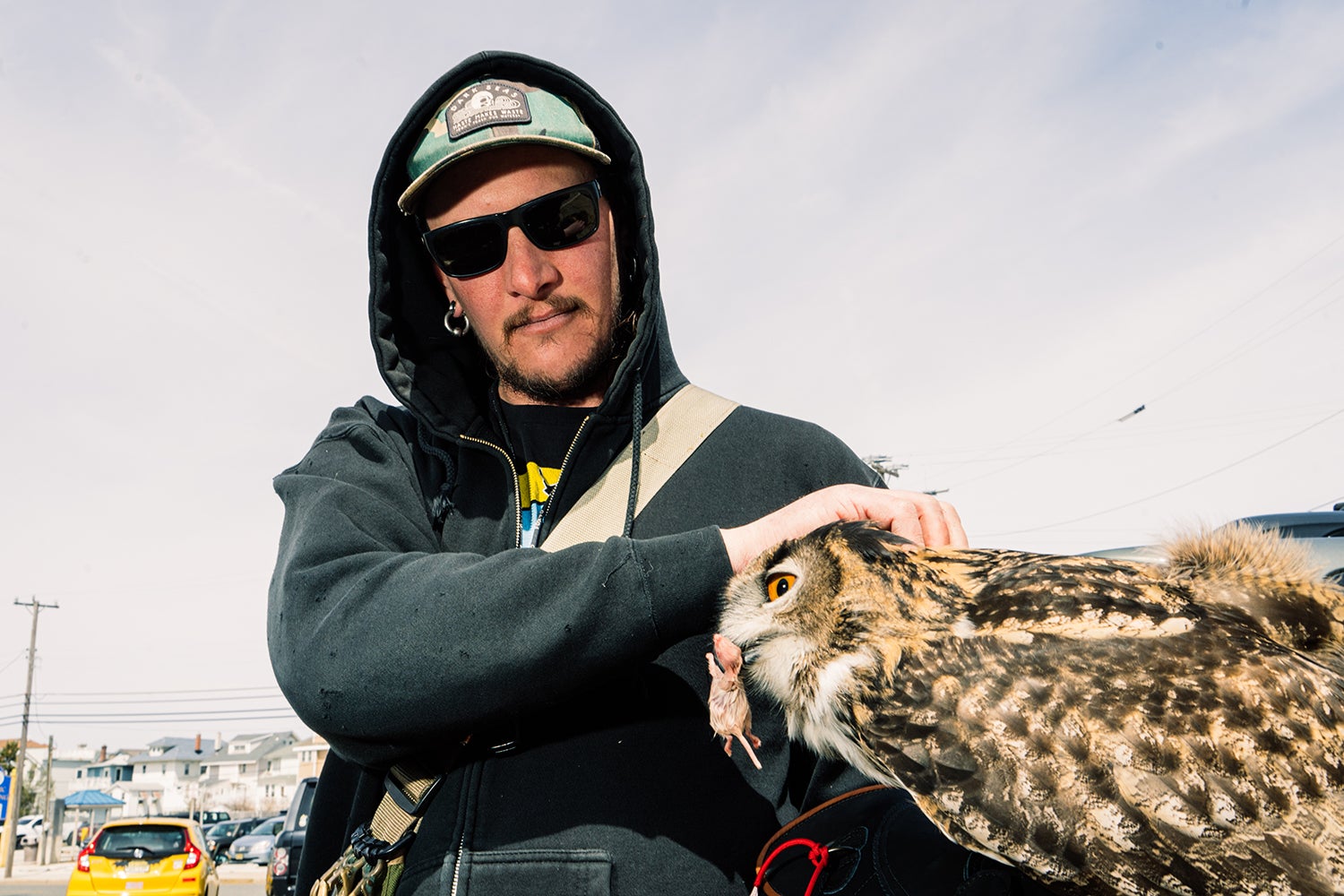 Falconer Mark Quinnette feeds Ozzy a mouse after the two patrol the beach and boardwalk. Jutharat Pinyodoonyachet for Popular Science
Falconer Mark Quinnette feeds Ozzy a mouse after the two patrol the beach and boardwalk. Jutharat Pinyodoonyachet for Popular Science
In fact, the early adopters of modern falconry played a large role in the rise of the conservation movements of the mid-20th-century. Magazines like Popular Science highlighted the art and helped younger people get interested in falconry, wildlife biology, and conservation.
Experts in the practice began to organize and pressure legislators when the peregrine falcon nearly vanished in the US due to the chemical DDT. Falconers also raised concerns about decreasing numbers of golden eagles and were even able to advocate for the Migratory Bird Treaty Act of 1972 to cover migratory raptors. An additional 32 families of birds were protected with the landmark new law. This piece of federal legislation has since been amended multiple times to cover different raptor species.
“There’s been some misunderstandings about falconry that have led to some conflicts with the community and various advocacy groups, but they haven’t ever been that big of a deal,” says John Goodell, the executive director of the historical repository Archives of Falconry. “Unlike [some] mammals, raptors actually tend to thrive in captivity. They usually double their lifespan in captivity, just because there are so many things that can kill a raptor in the wild.”
In the States, those who pursue this unique trade and tradition must learn and pass an advanced test that encompasses raptor biology, ecology, and natural history. They then have to complete a two-year apprenticeship. Apprentices can work with captive-bred raptors for both hunting and abatement, as long as they are working under a license.
One of the boardwalk falconers, an Ocean City local named Mark Quinnette, is fulfilling a childhood dream of becoming a falconer. A lifelong surfer and former manager at 7th Street Surf Shop, he taught Swanson how to ride Ocean City’s waves, while Swanson taught him about falconry. Quinnette soon became Swanson’s apprentice and is now an East Coast Falcons employee. When he is not patrolling the boardwalk in the summer with Ozzy or Diambi, Mark hunts in the winter with his own red-tailed hawk named Awilda Rose.
While a red-tailed hawk’s strong talons (up to 1.33 inches long) and heavy wingbeats might seem intimidating, training a raptor is similar in method to drilling commands with a pet or even teaching behavior to a toddler. It uses the basic psychological principles of operant conditioning, which relies on positive reinforcement and food rewards to modify behavior. With raptors, however, there is a much smaller margin of error than with dogs. “You can’t be negative with them at all because they’ll just see you automatically as an enemy or a challenge,” explains Quinette.
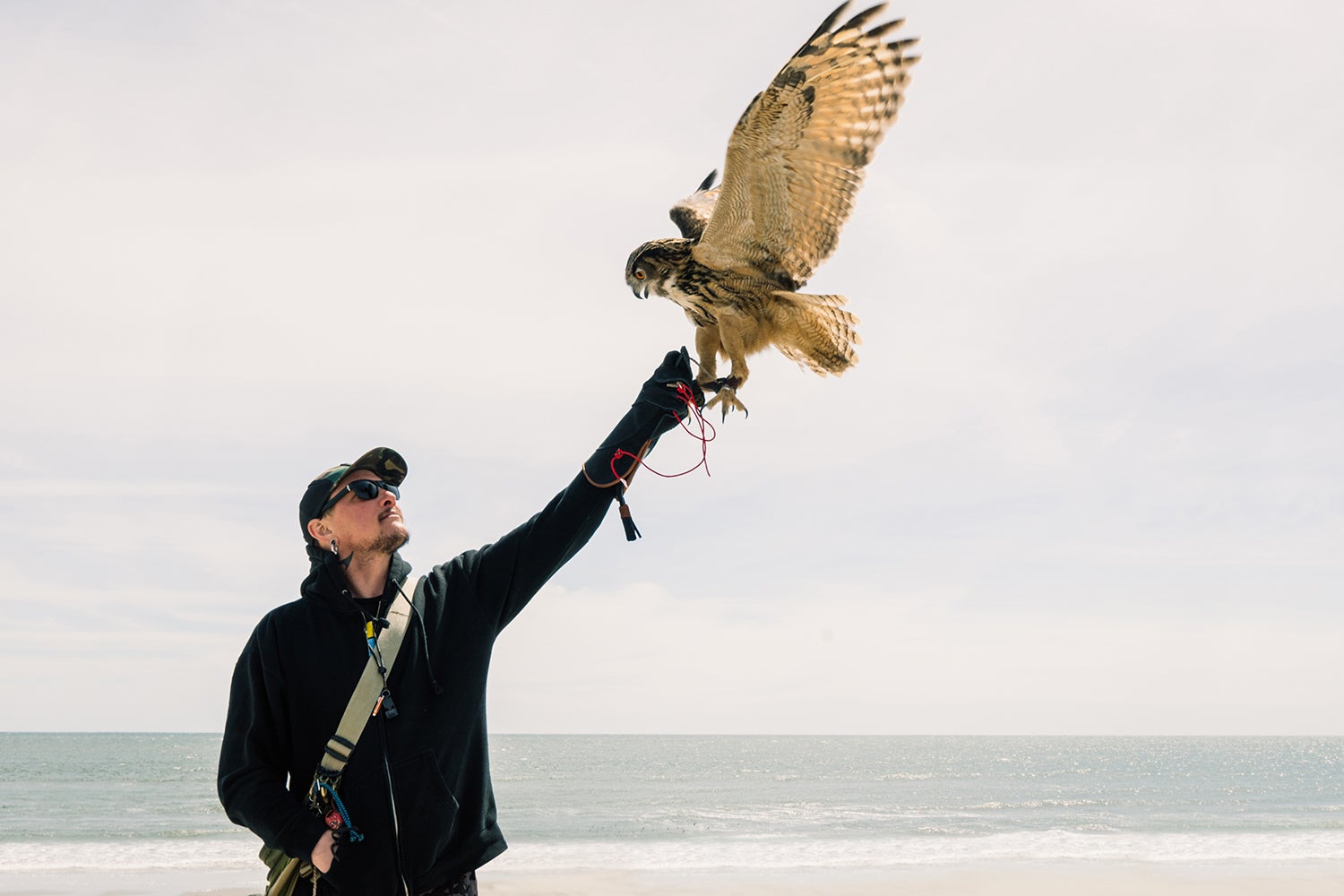 Quinnette works with Ozzy on the beach. The Eurasian eagle-owl is the longest-serving raptor on the boardwalk.
Quinnette works with Ozzy on the beach. The Eurasian eagle-owl is the longest-serving raptor on the boardwalk.
Jutharat Pinyodoonyachet for Popular Science
Typically, the more positive reinforcement with meaty treats, the better trained the animal will be. It takes about three weeks to a month for a falconer to train a raptor to respond to their instructions.
The fierce bouncers on the Ocean City boardwalk have been drilled to make their presence known, not felt. This means that there’s little combat in the air—strictly because the gulls won’t venture close. Instead of attacking or killing the gulls, the raptors use their presence to push them away from particular areas. The trainees learn very quickly that their human is a better source for a satisfying meal than anything they might encounter on their rounds.
Last summer, the team adopted a new approach whereby they started to introduce the raptors a little earlier in the season and in the morning when there is less gull activity. Since then, the younger gulls in particular learned rather quickly that there were predators in the area and would move out to the bay on the western side of the island. As more people hit the boardwalk and beaches in the early afternoon with their food, and gull activity increased, the falcons, hawks, and owls would go on patrol.
“They’re just really big and powerful birds, and they know their routine. They fly straight down the boardwalk, and [the gulls] clear out,” says Quinnette. In the mornings, the hawks cover a smaller, more concentrated area and fly lamppost to lamppost or store roof to store roof. Meanwhile, the falcons on the lure circle in figure eights, dives, and stoops that are more similar to their hunting movements.
The local avifauna can be heard warning each other when guards like Karen and Diambi are around. Ozzy the owl has the task of “putting the gulls to bed” with his nighttime patrol before the boardwalk closes.
As a highly regulated and federally permitted abatement program, East Coast Falcons makes sure the boardwalk doesn’t become a gull graveyard. That said, accidents can happen. According to Swanson, about eight gulls were killed by one of his birds during the 2022 season. “You’re working with a wild animal, so anything is possible.”
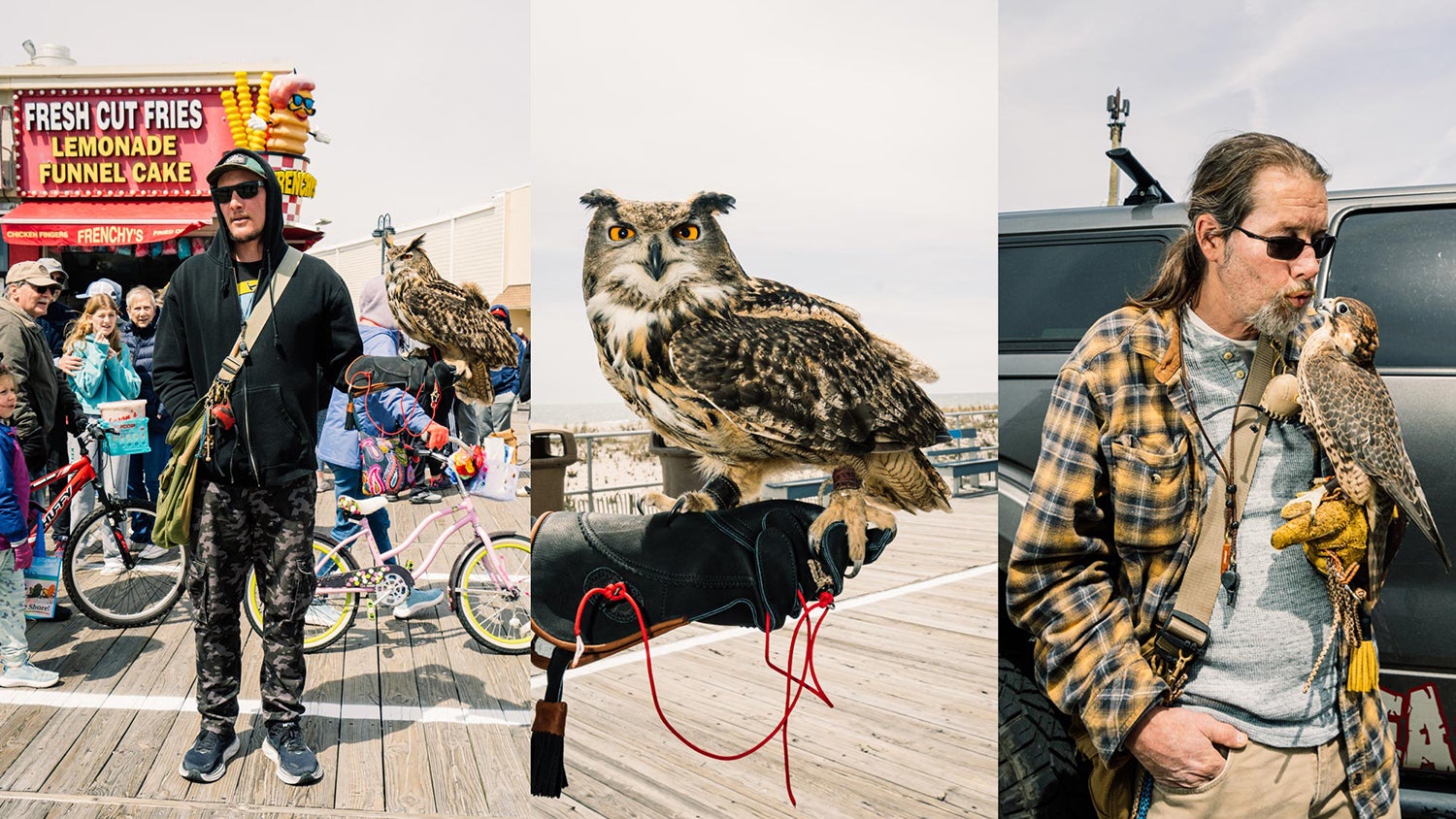 From left: Quinnette and Ozzy patrol the boardwalk in front of a popular french fry stand; Eurasian eagle-owls like Ozzy are among the largest owls in the world; East Coast Falcon owner Erik Swanson with Maple, a red-naped falcon. Jutharat Pinyodoonyachet for Popular Science
From left: Quinnette and Ozzy patrol the boardwalk in front of a popular french fry stand; Eurasian eagle-owls like Ozzy are among the largest owls in the world; East Coast Falcon owner Erik Swanson with Maple, a red-naped falcon. Jutharat Pinyodoonyachet for Popular Science
“What East Coast Falcons is doing is industry standard,” Hawkins says. Bird-on-bird attacks can be concerning for both sides, she adds, but it’s up to the falconers to make sure their charges are safe. “We strongly encourage those [raptors] get annual examinations and some bloodwork to make sure that they are as healthy as they possibly can be.”
To prevent regular wildlife fatalities, falconers fly their birds as high as possible over the boardwalk and manage the raptor’s weight in the mews. “You keep it low enough that they’re still going to come to you, and high enough that they’re not crazy hungry and want to kill everything they see,” says Quinnette. Despite being on the offensive, the winged predators generally never attack humans or other animals.
The falconers feed their birds a healthy natural diet of quail, mice, and rats. In the rare instance that one of the raptors doesn’t return, they use two different types of telemetry devices to track and retrieve them.
Some of East Coast Falcons’ feathered staffers are spot trained, meaning that the falconers have taught them what path to take and will work with those specific locations. One gyr-Barbary hybrid falcon named Strawberry particularly likes the Flanders Hotel on 11th Street. She will cruise up from 6th Street, spooking gulls along the way, and perch at the hotel knowing that one of the handlers will come and get her with some tidbits of food in tow.
Another method the falconers use involves a lure—cord with an object tied to its end that usually resembles a prey animal. A falconer swings the tool around and pulls it away the second the bird goes for it. The bird then looks for the lure again and again. The flight pattern and talon positioning makes it look like the raptor is primed to attack.
“We play games with the gulls,” Swanson says. “The gull believes that the falcon is actually hunting them. But then the falcon gets to where it [the gull] would be a really easy kill, [and] it’s not hungry enough. So it just turns off.”
That fear and avoidance is quite primal. Diambi is a gyr-saker hybrid. In the wild, saker falcons generally strike a death blow by hitting their prey at speeds of 150 miles per hour, while wild peregrine falcons in Ocean City can hit close to 300 miles per hour. Hawks and owls, meanwhile, use their talons to go in for the kill, squeezing the life out of their quarry with their grip. Red-tailed hawks like Awilda Rose can apply roughly 200 pounds of pressure; Eurasian eagle-owls like Ozzy apply about 700 pounds of pressure—equivalent to a wolf bite.
“There’s a respect for the fact that the animal can hurt you very badly, but is small enough to be handled,” says Hawkins. “When you handle them, you just feel the power of their muscles throughout their body.”
Flying the raptors high over the boardwalk to prevent unintended contact with a wild bird is also part of the team’s important task of keeping them healthy. “We take great pride in our birds and would hate to lose any to the bird flu,” says Quinnette. A global outbreak of highly pathogenic avian influenza has killed an estimated 58.79 million domestic birds in the US alone and possibly millions of wild birds, including raptors, over the past two years. More than 430 bald eagles and 22 endangered California condors have died from the disease in the US.
Nature will always win
As beach season heats up in Ocean City and tourists start to flock to the boardwalk, wildlife experts and falconers agree that humans, with all the ways they tempt gulls to act out of turn, are the true ecological problem.
“This is the real balance that I think that we have to have. How do we sort of keep problems at bay but at the same time give [the birds] space and resources to forage naturally?” asks Perlut, the ornithologist from the University of New England.
“Ultimately, it’s easier to train birds than humans,” says Quinnette. “[People] can fight Mother Nature all they want, but she’s ultimately going to win in the end. It’s just, at what cost?”
After patrolling 10th Street beach, Quinnette brings Ozzy back to the mews and feeds him a tiny mouse. Back on the boardwalk, word seems to spread that the owl’s shift has ended. Some gulls begin to circle Manco and Manco, perhaps searching for an easy slice of pizza.
Read more PopSci+ stories.
>>> Read full article>>>
Copyright for syndicated content belongs to the linked Source : Popular Science – https://www.popsci.com/environment/ocean-city-nj-falcons/































